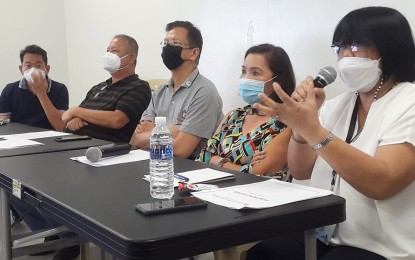
TANNERY INDUSTRY. Department of Trade and Industry (DTI) Bulacan Provincial Director Edna Dizon (right) explains some of the measures to revitalize the dying tannery industry in Meycauayan City during a meeting on Thursday (Aug. 31, 2022). Also in the photo are tannery owners in the locality. (Photo courtesy of DTI Bulacan)
MALOLOS CITY, Bulacan – The Bulacan Micro, Small and Medium Enterprises Development Council, headed by the Department of Trade and Industry (DTI) provincial office, has laid out measures for the revitalization of the dying tannery industry in Meycauayan City.
DTI provincial director Edna Dizon said in a meeting at the Meycauayan City Hall on Wednesday that the tanning industry, for which Meycauayan has been known for in the last 100 years, is among the priority industries in Bulacan province that their agency is targeting to stimulate to give residents a good source of livelihood.
She noted, however, that the industry has significantly dwindled compared to the period before the turn of the 21st century.
Mary Lazaro, president of the Tanners Association of the Philippines (TAP), said Meycauayan City now only has less than 10 tanneries, way below the 200 tanneries before.
“The first of the steps is to determine where the tanneries in Meycauayan City can get the cow, buffalo, and goat skins to become raw materials for leather products,” Dizon said.
Based on DTI’s research, the tanneries in Luzon are getting almost no leather because the producers of "chicharon" or pork skin crackling are being given priority.
“Therefore, they are forced to source skin from the Visayas, Mindanao, and even other countries, which leads to high prices due to limited supply,” Dizon said in an interview.
With this, she said the DTI's target is to contact the Department of Agriculture (DA) and its attached agency, the Philippine Carabao Center, to ensure that there is a source of skin to be part of the country's livestock development.
Dizon also said they are seeking the allocation of new and suitable machinery to modernize the tanneries through the help of the Department of Science and Technology (DOST).
She said DOST Provincial Director Angelita Parungao assured them that the agency is ready to provide the necessary machinery and tools.
“The agency is prioritizing equipment that will collect waste from the tanneries so that it can be reused and not contaminate the rivers,” Dizon added.
The tannery industry is said to be one of the reasons the Marilao-Meycauayan-Obando River System was included in the list of the 30 most polluted rivers in the world in 2008.
Likewise, Dizon said the DOST is looking for ways how to increase the supply of salt in Bulacan which is one of the materials needed in the production of leather products.
She noted that the quality of salt used for food is different from that used in tannery.
To increase salt production, she said the DOST is looking for a beach that is closer to extraction and processing such as Pamarawan island in Malolos City.
Pending the implementation of major and long-term measures to revitalize the tannery industry in Meycauayan, the DTI has set a fashion week activity before the end of 2022.
“It's a fashion show that will feature leather goods and jewelry made in the city,” Dizon said.
She said they are also looking on how to borrow capital from the Small Business Corporation, Land Bank of the Philippines, and Development Bank of the Philippines under Republic Act 9501 or the Magna Carta for MSMEs Act of 2008.
Other measures include the revival of a cooperative with assistance from the Cooperative Development Authority and the creation of a technical working group that will formulate a master plan on how to have an integrated water waste treatment facility for all tanneries in the city. (PNA)
